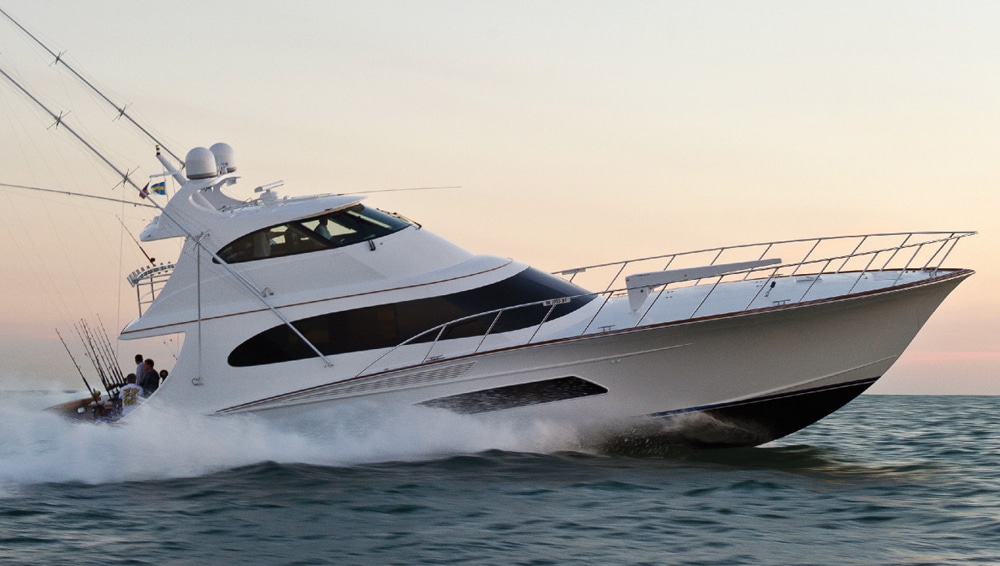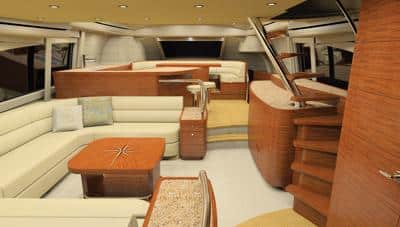
Spencer 70 IPS
Paul Spencer qualifies as about the most progressive custom boatbuilder in America. He pushes the limits even amidst naysayers. And so it has been with his several boats powered by Volvo Penta’s Inboard Propulsion System (IPS). Skeptics abound, but so far everyone who actually drives one develops the passion of a convert. It certainly doesn’t hurt that Spencer’s boats are all fast, beautiful and successful fishing machines no matter how they’re powered — which is why Volvo commissioned Paul Spencer to build its new corporate flagship to showcase the abilities and efficiencies of IPS power.
Penta Gone is a 70-footer with three engines totaling 2,700 horsepower. Most 70-footers will come with a pair of 2,400- or 2,600-horsepower diesels — almost twice the horsepower of Penta Gone. Consequently, weight and distribution became the most critical design challenges. Going back through many previous tests of comparable boats, my sea trial showed that this Steve French designed Spencer 70 IPS burned up to 40 percent less fuel than the higher-powered machines did at the same speeds. The balance of this boat is so exacting that it has barely measurable bow rise and the running attitude virtually never changes.
Leaving tiny Rudee Inlet in Virginia Beach, Virginia, conditions proved downright sporty, with six-foot seas and a hundred tiny johnboats dotting our path as they filled their bilges with speckled trout. Cruising straight into the offshore seas at 20 knots proved a nonevent — at least until we came suddenly upon some 8- to 10-footers that caused us to back off. Once past the shallows, we turned beam-to the seas and ran smoothly and dryly at 30 knots turning 2040 rpm.
Volvo QL trim tabs actually stem from a design by Humphree Interceptor trim tabs. Not only do they adjust fore, aft and lateral trim, but they shave four to six seconds off time to plane. They also work automatically as stabilizers.
Penta Gone was off to the Fort Lauderdale International Boat Show the following morning and had already been fully loaded with fuel. Despite this, I topped out at just over 38 knots turning 2362 rpm and burning 134 gallons per hour total. The triple 900-horsepower diesels burned about 77 gallons per hour at 25.5 knots while turning 1800 rpm. And where most boats this size cruise today — at 30 knots — we used a total of 108 gallons per hour. I’m certain a half-load of fuel would improve both speed and efficiency. With the pods rotating rather than rudders, this 70-footer turns beautifully at cruise and, when slowing, scribes an ever-tighter arc.
A common complaint from anglers and crew is that the IPS through-prop exhaust system deposits too much turbulence in the wake. On this boat, you can press a button and have cutoffs channel the exhaust through the transom. Seven knots showed a clean wake with the cutouts opened. There’s a “snail” button for slow trolling-valve mode.
Sport-fish mode on this boat qualifies as truly remarkable. Back down straight as an arrow at 10 knots without taking a drop over the covering boards. Spin like a 30-footer. Change direction like a quarter horse. And the dynamic positioning system will hold you within a few feet of any position.
Everything in the boat is weight conscious. The modular interior consists mostly of tri-cell coring and light-ply. The composite hull (with solid glass at each through-hull) has a layer of Kevlar over a foam composite core.
The fuel tank runs almost full length on centerline, placing the weight of the fuel on the center of gravity, so no matter what the fuel level, the attitude of the hull never changes.
The Volvo team made only minor design changes in the running surface of Spencer’s proven 70 hull, including more aggressive chines and decreased rocker at the transom.
Spencer moved equipment from the engine compartment to the forward cabin bilge for several reasons: to place the center of gravity accurately and to clean out the engine spaces since they end up needing considerably less room with IPS. As a result, this compartment turned out to be one of the most maintenance-friendly I have seen. Access to crew’s quarters, with its two athwartship singles, head and shower, is through the door in the engine room.
There are fine wood veneers and lots of ambient light below, but up top, the flybridge with its all black décor sucks up light like a sponge — and that’s purposeful. You see no reflection while looking through the flybridge windows when driving from the aft station.

From those aft overhang controls, you can see the fighting chair and everything else. On Penta Gone, the aft window opens, making the view much clearer.
Not that Volvo expects problems, of course, but the mezzanine, with refrigerators, freezers, stowage, Kenyon grill and the like, is completely removable. The transom livewell with its aquarium window is large enough to double as a sizable fish box.
The elevated galley affords an unobstructed view both outside and down into the cockpit. There’s an almost-full-width dining table all the way forward and the tinted cabin-front window provides a great view of the bow.
The master cabin has in-hull windows that look beautiful from the inside (not so much from the outside, in my opinion). There’s a guest double to port and the larger guest cabin in the bow sports an island queen berth and private head with shower. It also gives access to the unusual belowdecks compartment where lots of equipment that normally resides in the engine room hides.
It’s no secret that the offshore fishing community is change-averse. But pod propulsion represents a truly improved mousetrap. As for raising fish, during last summer’s tournament circuit, Penta Gone had one two-week stretch when it released 42 marlin. That’s good enough for me.
**
LOA:** 70’6″
Beam: 20’4″
Draft: 5’1″
Displ.: 83,000 lb.
Fuel: 1,380 gal.
Water: 220 gal.
Engines Tested: 3 x 900-hp Volvo IPS diesels
Price: Upon request
Spencer Custom Yachts, 252-473-6567; www.spenceryachtsinc.com; Volvo Penta, 757-436-2800; www.volvopenta.com









